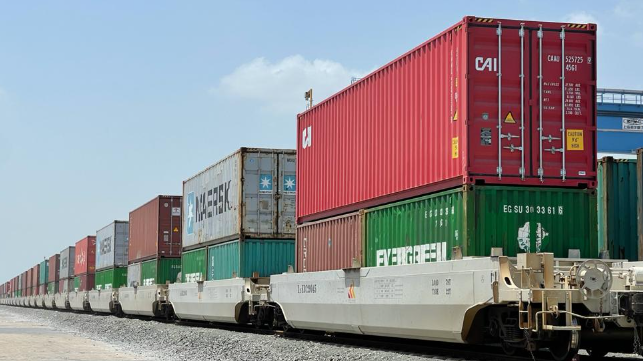Increase in Cargo at Mombasa Port Prompts Use of Double Stack Trains

Kenya has introduced the use of double stack trains to speed up the evacuation of cargo at the Port of Mombasa and deal with mounting congestion.
Kenya Ports Authority (KPA) said the double stack railing is aimed at improving cargo offtake by the standard gauge railway (SGR) freight service, with the cargo destined to the Nairobi container depot (ICD) in the capital.
“The service will transport 152 containers from the current 108 containers, enhancing faster cargo movement and increase efficiency at the port,” said KPA in a statement.
The decision to introduce double stack trains comes after the port, which is the main gateway to East Africa, witnessed a significant increase in cargo due to increase in trade, manufacturing and retail business following the easing of Covid-19 restrictions and lockdowns.
In recent months, Port of Mombasa has seen a significant increase in the number of vessel calls. Data by the Kenya National Bureau of Statistics show the port recorded an increase in throughput, handling 8.6 million tonnes of cargo in the third quarter of 2020 compared to 8.3 million tonnes in 2019.
While shipping and logistics stakeholders have hailed the move to introduce the double stack trains to boost efficiency at the port, the problem of congestion has been transferred to the Nairobi ICD, where a slow process of cargo release by the tax authority has made it impossible for importers to collect cargo fast enough.
This is because KPA is loading all cargo designed for inland and export onto the SGR, something that importers say has seen the ICD become a dumping ground for cargo which must be subjected to the process of scanning and verification by the Kenya Revenue Authority.
“We had started to have delays in offloading of cargo from ships but this has now been addressed with the introduction of double stack trains. However, the increase in the number of containers at the ICD is slowing down the release process,” said Wycliffe Wanda, Kenya International Freight and Warehousing Association CEO.
The use of double stack trains has seen the number of containers arriving at the ICD hit more than 1,200 daily. The Nairobi ICD, which was opened in 2018 at a cost of $200 million, has a capacity to handle 450,000 twenty-foot equivalent units (TEUs).
“The only way to make Mombasa port operate efficiently and seamlessly is to increase efficiency at corresponding facilities, particularly the Nairobi ICD,” said Wanda.
The Mombasa port has witnessed a steady increase in overall throughput, posting an 11 percent increase in 2019 to 34.4 million tonnes from 30.9 million the previous year.
With a capacity of 2.65 million TEUs, the Mombasa port has been named alongside Lagos in Nigeria, Dar es Salaam in Tanzania and Cape Town in South Africa among facilities in Africa that are nearing the maximum operating capacity of their existing infrastructure.
